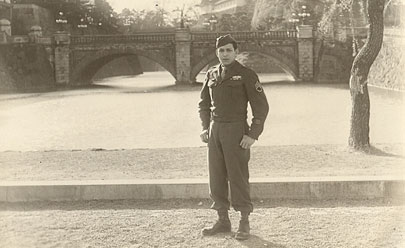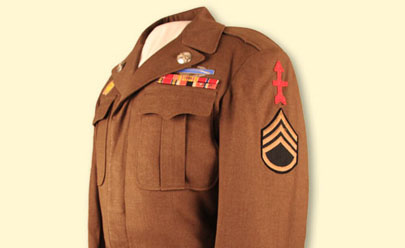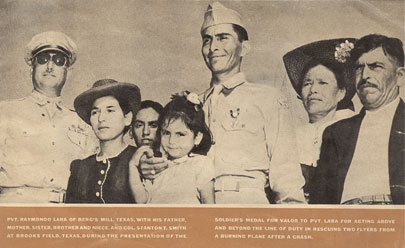FEATURED ARTIFACTS: HISPANIC AMERICAN
HERITAGE MONTH
Hispanic American Heritage Month
Each year, September 15 through October 15 is designated as National Hispanic Heritage Month. Nearly 500,000 Hispanic Americans served in the American military during World War II. The figures are imprecise because, except for Puerto Ricans, data on Hispanics was not collected. Over 53,000 Puerto Ricans served between 1940 and 1946, and an estimated 350,000 Mexican Americans entered the armed forces during the war.
Staff Sgt. James A. Mendez was one of them. A native of Los Angeles, Mendez enlisted in the US Army on 2 May 1944 at the age of 22. He entered service at Fort MacArthur, California, and served with the 127th Infantry Regiment of the 32nd Infantry Division in the Pacific Theater. He participated in the Southern Philippines and Luzon campaigns. For his service, he was awarded the Combat Infantryman Badge and the Bronze Star. Over the course of the war, 13 Hispanic Americans received the Congressional Medal of Honor.
Unlike African Americans, Hispanics were integrated into the military. But some National Guard units from Texas, New Mexico, California, and Puerto Rico had an especially high Hispanic representation. The war had a profound effect on the Hispanic community. Returning veterans began to challenge the widespread discrimination against Hispanics in American society.
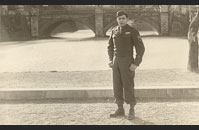 James A. Mendez in uniform in front of the Imperial Palace in Tokyo, Japan, during his occupation duty after the war. Mendez was honorably discharged on 5 May 1946 at Camp Beale, California.
James A. Mendez in uniform in front of the Imperial Palace in Tokyo, Japan, during his occupation duty after the war. Mendez was honorably discharged on 5 May 1946 at Camp Beale, California.
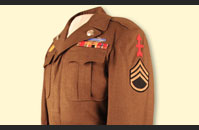 This “Ike” jacket was worn by Staff Sgt. James A. Mendez. For his service, he was awarded the Combat Infantryman Badge and the Bronze Star.
This “Ike” jacket was worn by Staff Sgt. James A. Mendez. For his service, he was awarded the Combat Infantryman Badge and the Bronze Star.
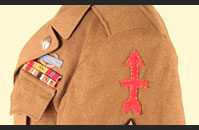 The 32nd Infantry Division earned its nickname, “the Red Arrow Division,” for actions during World War I. The red arrow then became the symbol on the sleeve insignia of the 32nd. In this photo you can also see part of the staff sergeant chevrons, and the following ribbons earned by Mendez: Good Conduct, Asiatic-Pacific Campaign with two stars, Bronze Star, WWII Victory, Army of Occupation, Philippine Liberation with two stars, and above is the Combat Infantryman’s Badge and postwar Military Police collar insignia.
The 32nd Infantry Division earned its nickname, “the Red Arrow Division,” for actions during World War I. The red arrow then became the symbol on the sleeve insignia of the 32nd. In this photo you can also see part of the staff sergeant chevrons, and the following ribbons earned by Mendez: Good Conduct, Asiatic-Pacific Campaign with two stars, Bronze Star, WWII Victory, Army of Occupation, Philippine Liberation with two stars, and above is the Combat Infantryman’s Badge and postwar Military Police collar insignia.
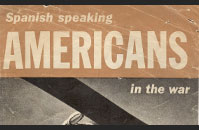 Front cover of a bilingual booklet in English and Spanish titled "Spanish Speaking Americans in the War: The Southwest," published by the Office of the Coordinator of Inter-American Affairs in Washington, D. C. during the war.
Front cover of a bilingual booklet in English and Spanish titled "Spanish Speaking Americans in the War: The Southwest," published by the Office of the Coordinator of Inter-American Affairs in Washington, D. C. during the war.
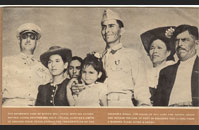 Page from the booklet "Spanish Speaking Americans in the War," with photos and stories of decorated Hispanic American servicemen.
Page from the booklet "Spanish Speaking Americans in the War," with photos and stories of decorated Hispanic American servicemen.
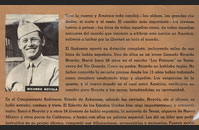 The “WAR CAME,” and it changed the lives of many Hispanic Americans. This is the story of Pvt. Ricardo Noyola from the booklet "Spanish Speaking Americans in the War."
The “WAR CAME,” and it changed the lives of many Hispanic Americans. This is the story of Pvt. Ricardo Noyola from the booklet "Spanish Speaking Americans in the War."

